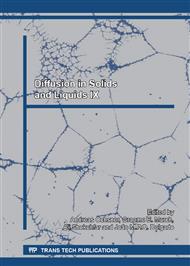p.263
p.269
p.275
p.280
p.286
p.292
p.298
p.306
p.311
A Mechano-Chemical Coupling for Hydrogen Diffusion in Metals Based on a Thermodynamic Approach
Abstract:
Hydrogen diffusion in metals is still an ongoing topic of research due to its technical relevance (hydrogen embrittlement, hydrogen storage...). In the last decades, significant progress in understanding the time evolution of the hydrogen concentration in solids was completed. This paper presents a modeling of hydrogen diffusion with a general and thermodynamically based diffusion concept coupled with mechanical and chemical aspects. This model was previously used to simulate the oxidation of a metal [1][2]. This concept has been upgraded to offer a thoroughly macroscopic behavior law used to simulate hydrogen diffusion in metal parts under mechanical loadings. The thermodynamic approach of the stress-diffusion coupling was implemented in a finite element code in order to study the hydrogen diffusion mode into a strained metal. Simulations were performed on a cylindrical austenitic steel tank under important internal pressure. The results of this study allow us to understand how hydrogen diffusion and mechanical stresses are mutually induced and modified.
Info:
Periodical:
Pages:
286-291
Citation:
Online since:
May 2014
Authors:
Keywords:
Price:
Сopyright:
© 2014 Trans Tech Publications Ltd. All Rights Reserved
Share:
Citation:


